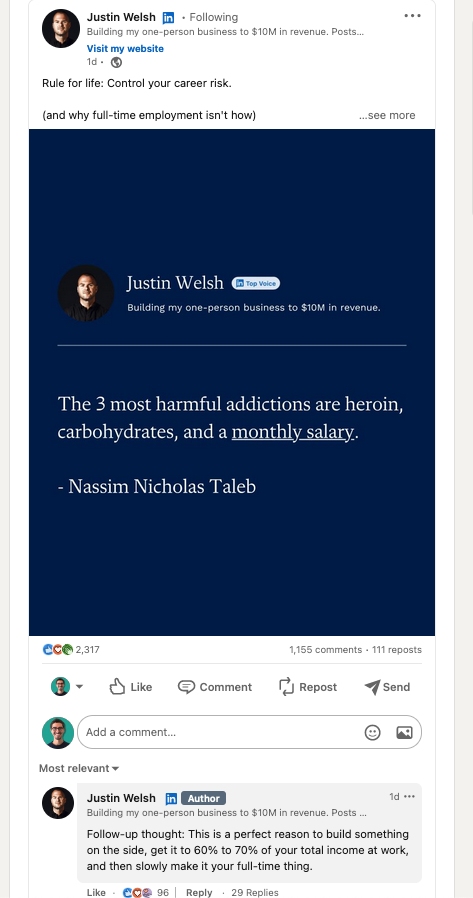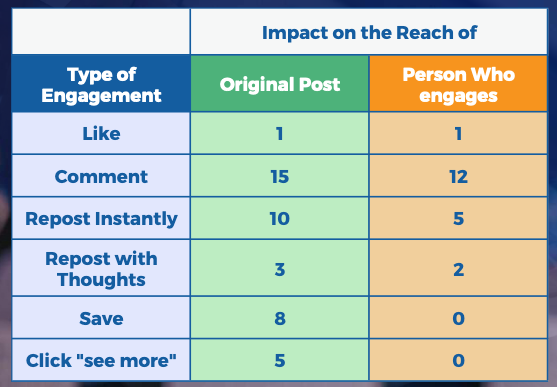While LinkedIn has been constantly tweaking its algorithm for the past three years, no update has been as significant as the one that took place in September 2023.
According to the 5th edition of Just Connecting HUB’s Algorithm Insights report based on the analysis of 215,000 LinkedIn posts, 95% of creators on the platform saw their reach drop by more than 50%, and for some, follower growth slowed to 40% compared to the previous year.
What's behind these jaw-dropping numbers?
The answer: LinkedIn's bold move to double down on users’ interactions with content.
Gone are the days of endlessly scrolling through photos of execs bragging in front of event booths.
Today, LinkedIn is on a mission to spotlight genuinely valuable content, transforming your feed into a goldmine of insightful, engaging material (well, it’s trying).
So, what does this mean for you and your LinkedIn strategy?
To understand, let’s first explore how LinkedIn’s algorithm delivers your content to the platform.
Check out the following articles here:
- Part 2 - Crafting the Perfect LinkedIn Post
- Part 3 - How to Comment Like a Pro
How does the LinkedIn algorithm distribute posts?
The main mechanism behind the LinkedIn algorithm is a kind of feedback loop that can be influenced positively or negatively by a variety of parameters, primarily focused on the quality of your post and your interactions with other users.
If your post validates signals that the algorithm recognizes as positive, it will continue to display your post to successive batches of users.
On the other hand, if a post is recognized as spam or if early batches of users do not interact with it, the algorithm will stop promoting your content.
This is how LinkedIn describes this process on their website:

The LinkedIn algorithm also uses a hierarchy of user groups to "test" the virality of your content and will deliver it in this order:
- Bell ringers: People who have opted in to receive notifications on your profile via the notification bell will be immediately notified of a new post. However, it is not certain that LinkedIn delivers it to the entire sample of people, and some sources claim it could be about 70% of them.
- Core circle: The users who interact with your content the most and mostly those who are followers. Some sources estimate that this could be about 7% of your followers.
- New connections: As we’ll see later, new connections are highly influenced and will see your content early.
- Active followers: Your followers who are actively using and engaging on the platform will see it next.
- Active connections: Finally, LinkedIn will expand to other connections, even beyond your initial connections (40% of your impressions could come from them).
To go beyond your close connections, users who are shown your content must continue to engage with it, but not all types of engagement are created equal.
Positive and negative signals measured by the LinkedIn algorithm
Every action users take on the platform - even passive ones like reading a post - is constantly measured and factored into the algorithm.
We can divide interactions into two groups: positive and negative engagement signals.
Let’s look at the positive signals first:
- Interactions with buttons such as Like, Comment and Repost.
- Clicks on "See More" to expand your post and read the full content
- Clicks on links, images, carousels, etc. included in your post
- Clicks on the "Save" option to bookmark your post
- New followers or connections gained from a post
- Users who share your post in direct messages
- Users spending extended time on your post
- Users who share your content outside of LinkedIn
On the other hand, some interactions can slow down the spread of your post.
These are:
- Users unfollowing you or removing their connection with you after engaging with your post
- Users quickly scrolling through your post
- Users answering ‘No’ when asked by LinkedIn if they find the content valuable
- Users not replying to a direct message related to your post
- Users not interacting when tagged in a post or removing the mention
LinkedIn does not disclose how all of these signals are weighted into the algorithmic balance, but thanks to the study done by Just Connecting HUB, we have an idea of how the most important interactions compare to each other.
The weight of interactions on your reach
Now that you understand how the feed works, let's take a look at how engagement on your post affects its reach (measured by the number of impressions).
To understand how this works, we should first look at ‘Likes’, as this is the basic and easiest form of engagement on your posts.
When you receive a Like on your post, it signals to LinkedIn that it should continue to promote it through the hierarchy of users that we've explored above.
It also has a slight acceleration effect, meaning that the more Likes you get, the faster the algorithm will deliver it to new batches of users.
The type of user who likes your post can also have an effect, and according to the Algorithm Insights 2024 report, Likes from users who are part of the same company as you can result in 15% less growth than other Likes.
The report also found that after 50 Likes, additional Likes may no longer impact your reach, and the algorithm prefers to look at other forms of engagement (I've noticed this myself on some of my posts).
Liking your own posts seems to have a slight growth effect (7.8% increase according to the report), which can feel a little awkward but is worth a try.
But Likes pale in comparison to Comments.
Comments on your posts are 15 times more powerful than Likes!
Yes, you read that right.
Having comments on your posts is the most direct way to increase your reach.
That's why it's so important to comment and invite people to comment.
I covered the topic of LinkedIn comments in a follow-up article, so I won't go into too much detail here.
But I can share with you a quick trick that has been slowly emerging over the past few months, which is to comment on your own posts 2 to 4 times after they are published.
The idea is that LinkedIn promotes your post in waves and by commenting on it, you can give a boost to the following waves of promotion and amplify the reach (25% growth according to the Algorithm Insights 2024 report).
To do this, simply wait an hour after publishing your post and write a comment that adds value to the original post.
You can then do this again, for example, 6 hours and 12 hours after publication.
LinkedIn influencer Justin Welsh does this regularly on his own posts:

The other two main interactions you want to encourage are 'Repost' and 'Save' as they can greatly impact your reach.
Don't forget that people who click ‘See More’ also increase your impression, and surprisingly, this counts even more than a simple ‘Like’.
In addition, by engaging with other people's posts shortly after they are published, you can increase the reach of your own posts (a mechanism we'll explore in the next article).
The Algorithm Insights 2024 report provides a handy chart to understand how interactions compare to likes:

9 parameters influencing the LinkedIn feed
In addition to everything I explained above, there are also nine parameters that can affect what other people see on their feed, and this is important to understand how this can impact the delivery of your posts.
So let’s look at them:
- New connections
Connecting with someone on LinkedIn has a big hidden benefit that LinkedIn doesn't tell you about. For the two weeks following the connection, LinkedIn will prominently display your content to them, which can be a huge boost if they engage. On the other hand, if they don't engage during this time, the visibility of your post in their feed will decrease.
- Interactions
This one is more obvious. Any interaction with your content, such as likes, comments, or reposts, increases the chances that future posts will appear in the feeds of people who have engaged.
- View time
Another hidden feature of LinkedIn: The amount of time people spend looking at your posts affects the algorithm. The longer they look at your posts, the more likely the algorithm is to show them more of your posts. That's why long-form text or infographics work so well on LinkedIn.
- Frequency
People who regularly interact with your content are more likely to see subsequent posts you publish. If they engage daily, the algorithm may even show them several of your posts in one session.
- Direct messages
When someone sends you a direct message, they are more likely to see your content in their feed (70% increase, according to the report). So inviting people to reach out to you via direct message might be a good strategy.
- Saving posts
If you can get people to save your posts, there's a 90% chance that the next post you publish will be shown to them. Creating informative posts with high-value information can help to incentivize people to save.
- Content type
The LinkedIn algorithm looks at what type of content people consume and like the most. For example, if they spend a lot of time watching videos, LinkedIn will show them more videos. The same goes for any other type of content. That's why it can be helpful to vary your content format, as we'll explore in an upcoming article.
- Profile visits
People who visit your profile are 50% more likely to see your new content in their feed. That's why your profile photo and description are so important.
- Sales Navigator
People who use Sales Navigator may see more content from saved leads. Of course, this is hard to use to your advantage, but it is good to know.
If you read between the lines, it becomes clear that the LinkedIn of 2024 is all about reciprocity.
The more people engage with you, the more they will see your content, and vice versa.
In its algorithm, LinkedIn maps the strong bonds that connect people and encourages them to interact even more by prioritizing their content.
But it's a two-way street, and the way you interact with others also has the effect of increasing your own reach.
That's the topic we'll be exploring next.





